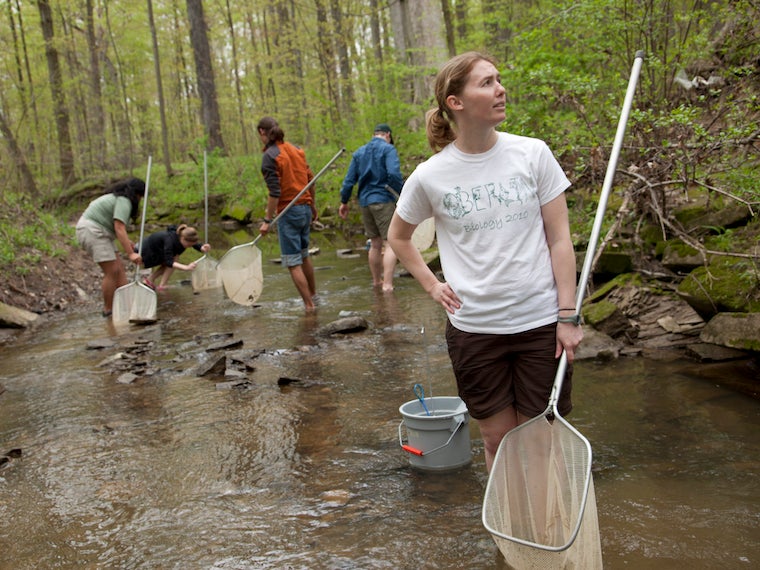Biology
Biology Field Sites
Oberlin students often accompany faculty members in a variety of local and regional field sites to conduct research.

- Camden Bog
Field trips for BIOL 202 Plant Ecology
Site for Ohio State University graduate student projects
Camden Lake and Bog Natural Area is a classic kettle bog about 10 miles southwest of Oberlin. It is the only open-water bog in North Central Ohio. Oberlin purchased the 19-acre site from the city of Oberlin in 1991, with a grant from the Nord Family Foundation. The bog formed after the last ice sheet retreated approximately 10,000 years ago. The site has six acres of open water surrounded by sphagnum bog, marsh, and deciduous forest. Many plant species representative of the North Central Ohio area are protected here, including six on the Ohio list of threatened and endangered species. The bog has supported numerous research projects in addition to class field trips. - Chance Creek Nature Preserve (managed by the Lorain County Metro Parks)
Field trips for BIOL 324 Plant Systematics and BIO 202 Plant Ecology
Located about 10 miles from campus, the Chance Creek Nature Preserve contains upland, slope, and bottomland forests that are bordered by the Vermilion River and Chance Creek. The preserve has 33 permanent plots that were first surveyed in 1974, providing a valuable baseline for continued studies of forest ecology. It is a popular area for nature hikes, as it provides welcome topographical relief, with 60’ shale cliffs and trails along the river where forests have been free of agriculture or timber removal for nearly a century. The land was donated to Oberlin College between 1928 and 1930.
- Lorain County Metro Parks Wellington Reservation
Research on signaling biology of American goldfinches
Research on disease ecology of gray catbirds
This 550-acre park was developed in 2005, through collaboration between the Lorain County Metro Parks and the Village of Wellington. It provides opportunities for hiking, biking, strolling, fishing, boating, and wildlife observation. The park includes a 21-acre lake, formed by the Wellington South Reservoir, allowing for exploration of wetlands and fish. it also has old fields, early successional forest and mature forest.
- Lorain County Metro Parks Sandy Ridge Reservation
Field trips for BIOL 309 Ornithology and BIOL 315 Behavioral Ecology
Sandy Ridge Reservation is a 310-acre wetland and wildlife preserve in North Ridgeville, about 15 miles east or 23 minutes from Oberlin. The park opened in 1999, and is one of the most popular parks for birding in Lorain County. The reservation lies on level, soggy ground flanked to the north and south by ancient beach ridges and consists of forests and open lands to explore.
- Old Woman Creek National Estuarine Research Reserve
Field trips for BIOL 202 Plant Ecology and BIOL 411 Conservation Biology
Nate Wehr ’16 collected data for his BIOL 501-502 Honors research project
Located in Huron, Ohio, on the South Central shore of Lake Erie, Old Woman Creek is one of the state’s few remaining examples of a natural estuary. As a transition zone between land and water, the site has a variety of habitats including marshes and swamps, upland forests, open water, tributary streams, barrier beach, and nearshore Lake Erie. The reserve, about 27 miles west of Oberlin, supports a variety of native plants and animals representative of freshwater estuaries.
- Pickerel Creek Wildlife Area
Field trip for BIOL 309 Ornithology
Pickerel Creek Wildlife Area lies between the South Shore of Sandusky Bay and U.S. Route 6 in Townsend and Riley townships, Sandusky County. The area totals 3,200 acres, most of which has been restored to wetland with the remainder in woods, brush, and native grassland. Pickerel Creek flows through the western half of the area, forming a high quality freshwater estuarine habitat. Located about 50 miles west of Oberlin, its geographic location also accounts for high numbers of bald eagles, song birds, shorebirds, and hawks during the spring and fall migrations and such upland game animals and furbearers as cottontail rabbit, white-tailed deer, woodchuck, muskrat, among others.
- Lake Erie
Field trip for BIOL 309 Ornithology
The warmest and fourth-largest lake (by surface area) of the five Great Lakes in North America, and 11th-largest globally if measured in terms of surface area, Lake Erie offers many opportunities for field study, ranging from ecosystems to invasive species, and from water quality to restoration and conservation issues.
- Agusta-Anne Olsen State Nature Preserve
Field trip for BIOL 324 Plant Systematics and BIOL 202 Plant Ecology
The Augusta-Anne Olsen preserve contains 132 acres of forest and meadow, with some of the most diverse remaining forest in north central Ohio.
- Edison Woods MetroPark
Field trip for BIOL 324 Plant Systematics and BIOL 202 Plant Ecology
Edison Woods in an approximately 1,300 acre park that has some of the largest contiguous forest in northern Ohio.
- Lorain County Metro Parks Vermillion River Reservation
Field trip for BIOL 324 Plant Systematics and BIOL 309 Ornithology
Located along the Vermillion River, the Bacon Woods represents an area of riparian forest with a diverse understory of wildflowers.
- Cleveland Botanical Gardens
Field trip for BIOL 324 Plant Systematics
Cleveland Botanical Garden contains numerous indoor and outdoor gardens including an Ohio forest natural area and two conservatories; one representing a Costa Rican rainforest and the other a Madagascan dry forest.
- Chihuahuan Desert
Field trip for research students in the Moore lab
The Chihuahuan Desert is the largest desert in North America, spanning much of southern New Mexico, west Texas, and north-central Mexico. Ongoing research in the lab of Professor Mike Moore investigates the evolution and ecology of an unusual group of plant species that grows only on the mineral gypsum. Students in the Moore lab often accompany Prof. Moore on field trips to the United States‘ portion of the Chihuahuan Desert.
Watch an exploration of the desert